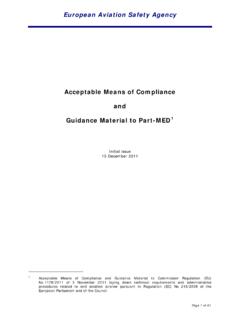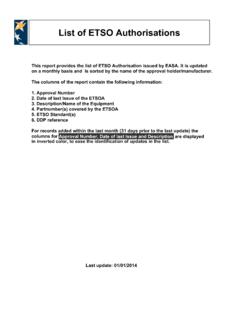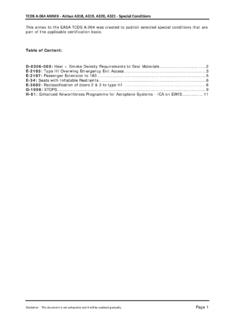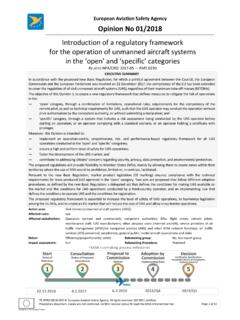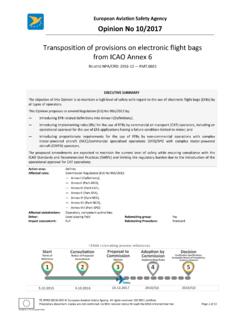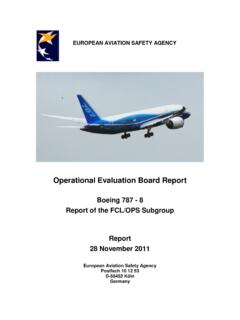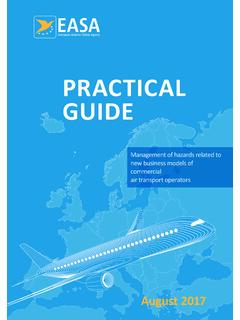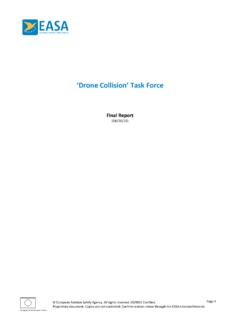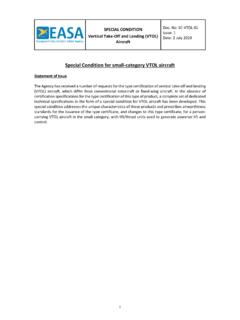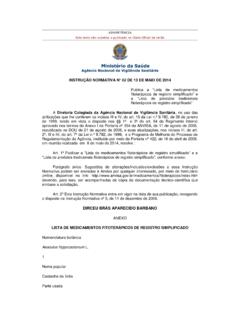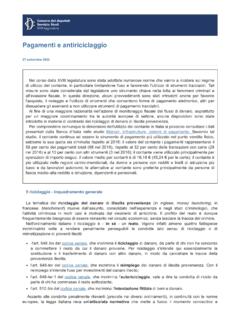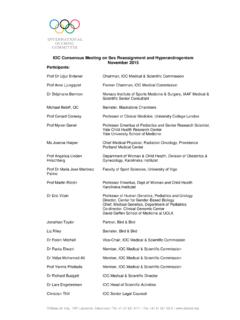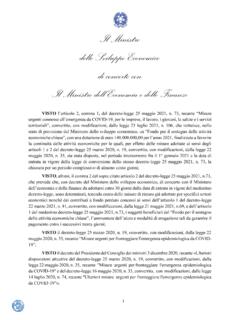Transcription of Annexes to the draft Commission Regulation on ‘Air ...
1 Annexes to the draft Commission Regulation on Air Operations - OPS Annex I Definitions for terms used in Annexes II-VIII ANNEX I DEFINITIONS FOR TERMS USED IN Annexes II-VIII 1. For the purpose of this Regulation , the following definitions shall apply: Accelerate-stop distance available (ASDA) means the length of the take-off run available plus the length of stopway, if such stopway is declared available by the State of the aerodrome and is capable of bearing the mass of the aeroplane under the prevailing operating conditions. Acceptable Means of Compliance (AMC) are non-binding standards adopted by the Agency to illustrate means to establish compliance with Regulation (EC) No 216/2008 and its Implementing Rules. Acceptance checklist means a document used to assist in carrying out a check on the external appearance of packages of dangerous goods and their associated documents to determine that all appropriate requirements have been met with.
2 Adequate aerodrome means an aerodrome on which the aircraft can be operated, taking account of the applicable performance requirements and runway characteristics. For the purpose of passenger classification: (a) adult means a person of an age of 12 years and above; (b) child/children means persons who are of an age of two years and above but who are less than 12 years of age; and (c) infant means a person under the age of two years. Aeroplane means an engine-driven fixed-wing aircraft heavier than air that is supported in flight by the dynamic reaction of the air against its wings. Aided night vision imaging system (NVIS) flight means, in the case of NVIS operations, that portion of a visual flight rules (VFR) flight performed at night when a crew member is using night vision goggles (NVG).
3 Aircraft means a machine that can derive support in the atmosphere from the reactions of the air other than the reactions of the air against the earth s surface. Alternative means of compliance are those that propose an alternative to an existing Acceptable Means of Compliance or those that propose new means to establish compliance with Regulation (EC) No 216/2008 and its Implementing Rules for which no associated Acceptable Means of Compliance have been adopted by the Agency. anti -icing , in the case of ground procedures, means a procedure that provides protection against the formation of frost or ice and accumulation of snow on treated surfaces of the aircraft for a limited period of time (hold-over time). Balloon means a lighter-than-air aircraft which is not engine-driven and sustains flight through the use of either gas or an airborne heater.
4 Cabin crew member means an appropriately qualified crew member, other than a flight crew or technical crew member, who is assigned by an operator to perform duties related to the safety of passengers and flight during operations. Category I (CAT I) approach operation means a precision instrument approach and landing using an instrument landing system (ILS), microwave landing system Page 2 of 202 Annex I Definitions for terms used in Annexes II-VIII (MLS), GLS (ground-based augmented global navigation satellite system (GNSS/GBAS) landing system), precision approach radar (PAR) or GNSS using a satellite-based augmentation system (SBAS) with a decision height (DH) not lower than 200 ft and with a runway visual range (RVR) not less than 550 m for aeroplanes and 500 m for helicopters. Category II (CAT II) operation means a precision instrument approach and landing operation using ILS or MLS with: (a) DH below 200 ft but not lower than 100 ft; and (b) RVR of not less than 300 m.
5 Category IIIA (CAT IIIA) operation means a precision instrument approach and landing operation using ILS or MLS with: (a) DH lower than 100 ft; and (b) RVR not less than 200 m. Category IIIB (CAT IIIB) operation means a precision instrument approach and landing operation using ILS or MLS with: (a) DH lower than 100 ft, or no DH; and (b) RVR lower than 200 m but not less than 75 m. Category A with respect to helicopters means a multi-engined helicopter designed with engine and system isolation features specified in the applicable airworthiness codes and capable of operations using take-off and landing data scheduled under a critical engine failure concept that assures adequate designated surface area and adequate performance capability for continued safe flight or safe rejected take-off in the event of engine failure.
6 Category B with respect to helicopters means a single-engined or multi-engined helicopter that does not meet Category A standards. Category B helicopters have no guaranteed capability to continue safe flight in the event of an engine failure, and unscheduled landing is assumed. Certification Specifications are technical standards adopted by the Agency indicating means to show compliance with the essential requirements of Annexes I, IV and Va to Regulation (EC) No 216/2008. Circling means the visual phase of an instrument approach to bring an aircraft into position for landing on a runway/FATO that is not suitably located for a straight-in approach. Clearway means a defined rectangular area on the ground or water under the control of the appropriate authority, selected or prepared as a suitable area over which an aeroplane may make a portion of its initial climb to a specified height.
7 Cloud base means the height of the base of the lowest observed or forecast cloud element in the vicinity of an aerodrome or operating site or within a specified area of operations, normally measured above aerodrome elevation or, in the case of offshore operations, above mean sea level. Code share means an arrangement under which an operator places its designator code on a flight operated by another operator, and sells and issues tickets for that flight. Congested area means in relation to a city, town or settlement, any area which is substantially used for residential, commercial or recreational purposes. Page 3 of 202 Annex I Definitions for terms used in Annexes II-VIII Contaminated runway means a runway of which more than 25% of the runway surface area within the required length and width being used is covered by the following: (a) surface water more than 3 mm ( in) deep, or by slush, or loose snow, equivalent to more than 3 mm ( in) of water; (b) snow which has been compressed into a solid mass which resists further compression and will hold together or break into lumps if picked up (compacted snow); or (c) ice, including wet ice.
8 Contingency fuel means the fuel required to compensate for unforeseen factors that could have an influence on the fuel consumption to the destination aerodrome. Continuous descent final approach (CDFA) means a technique, consistent with stabilised approach procedures, for flying the final-approach segment of a non-precision instrument approach procedure as a continuous descent, without level-off, from an altitude/height at or above the final approach fix altitude/height to a point approximately 15 m (50 ft) above the landing runway threshold or the point where the flare manoeuvre shall begin for the type of aircraft flown. Converted meteorological visibility (CMV) means a value, equivalent to an RVR, which is derived from the reported meteorological visibility. Crew member means a person assigned by an operator to perform duties on board an aircraft.
9 Critical phases of flight in the case of aeroplanes means the take-off run, the take-off flight path, the final approach, the missed approach, the landing, including the landing roll, and any other phases of flight as determined by the pilot-in-command or commander. Critical phases of flight in the case of helicopters means taxiing, hovering, take-off, final approach, missed approach, the landing and any other phases of flight as determined by the pilot-in-command or commander. Damp runway means a runway where the surface is not dry, but when the moisture on it does not give it a shiny appearance. Dangerous goods (DG) means articles or substances which are capable of posing a risk to health, safety, property or the environment and which are shown in the list of dangerous goods in the Technical Instructions or which are classified according to those Instructions.
10 Dangerous goods accident means an occurrence associated with and related to the transport of dangerous goods by air which results in fatal or serious injury to a person or major property damage. Dangerous goods incident means an occurrence other than a dangerous goods accident associated with and related to the transport of dangerous goods by air, not necessarily occurring on board an aircraft, which results in injury to a person, property damage, fire, breakage, spillage, leakage of fluid or radiation or other evidence that the integrity of the packaging has not been maintained. Any occurrence relating to the transport of dangerous goods which seriously jeopardises an aircraft or its occupants is also deemed to be a dangerous goods incident. Page 4 of 202 Annex I Definitions for terms used in Annexes II-VIII De-icing , in the case of ground procedures, means a procedure by which frost, ice, snow or slush is removed from an aircraft in order to provide uncontaminated surfaces.
